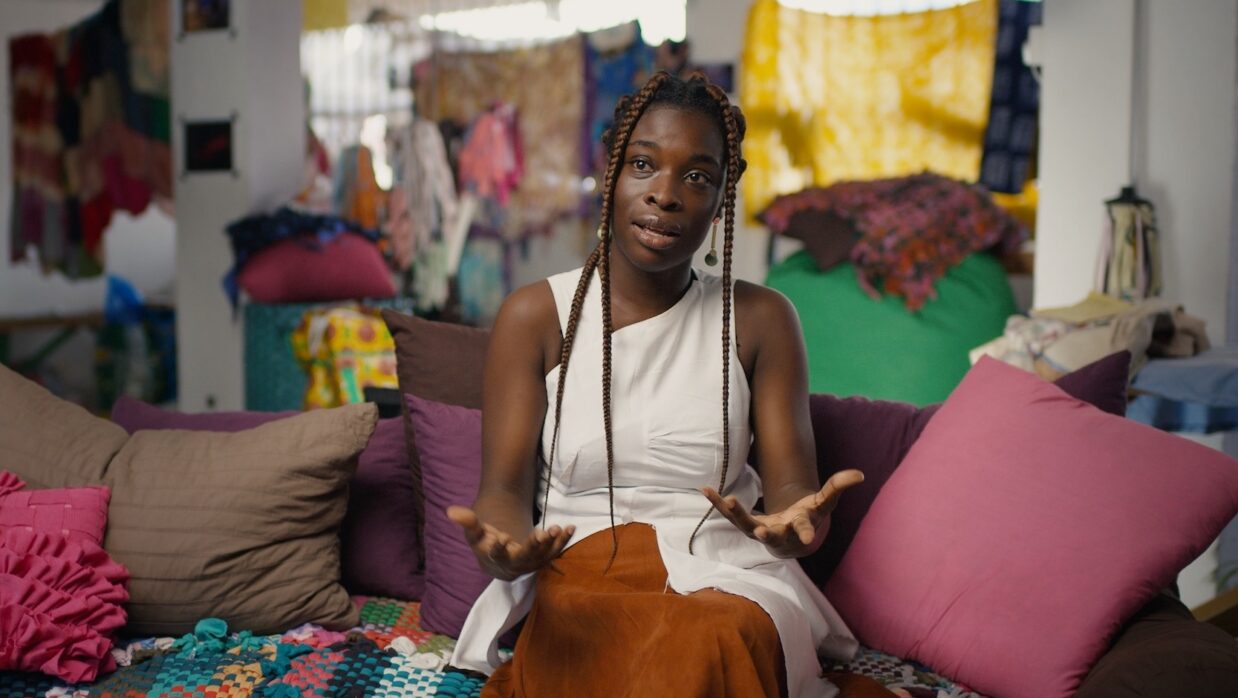
By Gen Terblanche7 November 2024
5 jaw-dropping moments in HBO documentary Brandy Hellville
Whether you can recite Miranda Priestly’s monologue from The Devil Wears Prada, you’re a Shein queen, you’re addicted to decluttering videos, or the only time you stock up on clothes is when people give you underwear for Christmas, you can’t escape fast fashion.
“From the beginning of the supply chain to the end, we’re all being exploited by the same system,” notes Chloe Asaam, Ghana operations manager for The OR Foundation, which aims to raise global awareness of waste colonialism.

Over the course of an hour and a half, Eva Orner, director of fashion documentary Brandy Hellville & The Cult of Fast Fashion, will have your jaw on the floor as she spotlights the owners who reap profits and dodge the consequences, the teenage influencers who turned the Brandy Melville brand into an obsession, and the Ghanaian recyclers at the end of the line who get inundated with over 7.5 million pounds (around 3.4 million kg) of “donated” fast fashion from the US every week.
Here are just five moments that shook us.
Stream Brandy Hellville & The Cult of Fast Fashion now.
1. The sheer, staggering numbers

Teen Vogue contributing editor Alyssa Hardy reveals that the Zara brand started the trend of releasing new lines each week, effectively turning the three-season fashion cycle into a 52-week cycle. Some new brands have now taken that even further, with Shein boasting that they drop an average of 1 000 new clothing items every week. Then, after each piece has been worn a couple of times, conscientious consumers put their discarded clothes in donation bins. From there, according to Sammy Oteng of the OR Foundation, every week the global North sends around 15 million unwanted clothing items to Accra’s Kantamanto market in Ghana … a country of just 32 million people.
2. Beachwear nightmare

Sammy estimates that around 40% of the garments that come into Kantamanto market are of such poor quality that they go directly into the waste stream, where they are either burned or pushed into the City’s gutter system, which takes them out to sea. A scene straight out of The Lorax reveals a grey “beach” in Accra that’s so choked in textile waste, that waves of fabric wash over a shore suffocated under filthy mounds of rags.
Chloe Assam describes the fabric twisting into long “tentacles” the length of her whole body. And Liz Ricketts of the OR Foundation reveals that their cleanup crews have dug down as far as eight feet (2.44 metres – so the tallest man alive would be buried to over his eyes) into clothing mounds on the beach without hitting sand. As Liz points out, the sea floor around Accra probably looks just like the beach does – a fast fashion wasteland.
3. A Melville maze
When investigative journalist Kate Taylor first started looking into who owned Brandy Melville, she reveals, “Everything about this brand gets pretty confusing pretty quickly … Experts told me that it is probably deliberately confusion.” The identity of the company’s CEO wasn’t publicly available. There was no company mission statement and each Brandy Melville store was run by a different shell company. It took digging to expose the one name connected them all: middle-aged Italian immigrant Stephan Marsan.
At the time that Kate was investigating, Stephan had no online presence, and nor did his business partner Jessy Longo – a bald man in his late-30s. Behind a shield of anonymity, Jessy ran Brandy Melville’s instagram account and between himself and Stefan, they looked through masses of images of young teenagers doing their online ’fit checks, and invited a select few to show Brandy Melville more.
4. Brandy Heilville
Keeping the executives’ identities in the dark hid their real agenda. One lawsuit against Brandy Melville revealed that Stefan Marsan ordered store managers to fire anyone he didn’t find sexually attractive. And what he found attractive was girls aged 14 to 18 who hadn’t finished growing into their bodies. So Brandy Melville’s fast fashion pattern of consumption and rejection included the influencers themselves.
Another court case reveals the extent to which bigotry was ingrained in internal communications between senior leadership, on a group chat called Brandy Melville Gags. To single out just a handful of posts, a “joke” from Stefan featured an image of someone arranging a T-shirt slogan so that the lettering read “Hitler”, a comment claimed that TV show Happy Days was happy because there were no Black performers in it, and a black and white photo showed an anorexic woman wearing a beauty queen sash proclaiming her Miss Auschwitz. It all underlined the cornerstone of the Brandy Melville aesthetic and why it upheld young, thin, white, blonde teenage girls as the company’s ideal.
5. The importance of grooming
While “less favoured” (brunette, Black, Asian, and Latino) teens did the grunt work of stocking the stores and running the tills, Brandy Melville’s executives groomed a select few who matched their aryan ideal with special privileges, photoshoots, trips to the company’s factories in Italy and China, and even the use of the company Uber account. They were lucky the way that a force-fed goose is lucky for getting so much delicious grain.
Some of these hand-picked employees were invited to live in the company’s New York flat while visiting the city, but would come home or wake up to find that some man they’d never met before had moved into one of the other rooms. And one of the girls reported being taken out to dinner by a businessman who had moved into the flat, who then drugged and raped her. Just 21 years old at the time, she was too afraid of losing her job and her green card to report the assault.
It’s an illuminating look into the true human cost of a revolutionary business model, what drove it, and how it continues to impact global fashion and consumer trends.
Stream Brandy Hellville & The Cult of Fast Fashion now. And if you’re fashion conscious, also watch:
Style Magnate Season 1: Showmax Nigeria’s Original fashion design reality competition series features Nigerian fashion designer and icon Mai Atafo as mentor, stylist and costume designer Yolanda Okereke as the Fashion Principal, and Joseph Benjamin as host. Twenty young designers tackle a series of challenges with a massive prize at stake, including a three-month internship.
Victoria’s Secret: Angels and Demons: True crime documentary series directed by Matt Tyrnauer. On the runway, the world’s most famous models put on a dazzling lingerie show with their angel wings. But behind the scenes the promise of access to vulnerable young women drew exploiters from all corners, including sex trafficker Jeffrey Epstein.
Suited: This slow fashion HBO doccie, directed by Jason Benjamin, offers a behind-the-scenes look at the Brooklyn tailoring company Bindle and Keep, who specialise on tailoring and designing for non-binary clients. We get to meet six of their clients as they discuss their lives and identities, and how they’re dressing non-standard bodies in a way that gives them joy.
More eye-opening documentaries

10 South African true-crime series, ranked
From The ABC Killer to Tracking Thabo Bester, these true-crime documentary series explore some of South Africa’s darkest crime stories – all available to stream on Showmax.

Eye-opening homegrown documentaries to stream
These unmissable South African shows and movies deliver surprising insights on the country we’re living in today.

Wild Wild Space and 10 more titles to join your space race
We have liftoff! As new HBO documentary Wild Wild Space takes us into low orbit, mission control has 10 more titles ready for space junkies, from Apollo 13 to Interstellar.

Anatomy of Lies: Women who con
Grey’s Anatomy’s most shocking medical case took place behind the scenes. Find out how co-executive producer and writer Elisabeth Finch faked cancer and personal tragedy, and meet five more of the world’s most questionable con women.
